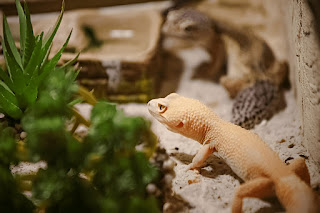How to Set Up a Reptile Terrarium: A Step-by-Step Guide
Creating a suitable terrarium for your reptile is essential for their health, comfort, and happiness. Whether you’re a first-time reptile owner or an experienced enthusiast, this guide will help you set up a terrarium that meets your pet’s specific needs.
1. Choose the Right Terrarium
a. Consider the Species
- Different reptiles have varying needs for space, humidity, and temperature.
- Research your reptile’s natural habitat to determine the size and type of enclosure.
b. Types of Terrariums
- Glass Enclosures: Ideal for reptiles requiring high visibility and moderate humidity.
- Screen Enclosures: Best for species needing excellent ventilation, like chameleons.
- Plastic or PVC Enclosures: Durable and effective for maintaining heat and humidity.
c. Size Matters
- Provide ample space for your reptile to move, climb, or burrow.
- For example, a leopard gecko requires a minimum of a 20-gallon tank, while a bearded dragon may need a 75-gallon enclosure or larger.
2. Install the Right Substrate
a. Choose an Appropriate Substrate
- Sand: Suitable for desert species like bearded dragons but must be fine-grained and safe for ingestion.
- Coconut Fiber: Retains moisture well, making it ideal for tropical reptiles.
- Reptile Carpet: A reusable, easy-to-clean option for various species.
b. Avoid Harmful Substrates
- Do not use cedar or pine shavings, as they release oils that can be toxic to reptiles.
3. Control Temperature and Lighting
a. Heating
- Install a heat lamp or ceramic heat emitter to maintain the required temperature gradient.
- Use a thermostat to prevent overheating.
- Provide a basking spot and a cooler area to allow your reptile to regulate its body temperature.
b. Lighting
- UVB Lighting: Essential for reptiles like bearded dragons and turtles to synthesize vitamin D3.
- Use a timer to mimic natural daylight cycles, typically 12 hours on and 12 hours off.
c. Monitoring
- Use thermometers and hygrometers to monitor temperature and humidity levels accurately.
4. Maintain Proper Humidity
a. Research Humidity Needs
- Desert species typically require lower humidity levels (20-40%), while tropical species may need 70% or higher.
b. Increase Humidity
- Use a misting system, fogger, or a water dish to raise humidity levels.
- Incorporate live plants or moist substrates to retain moisture.
c. Decrease Humidity
- Improve ventilation by using screen lids or additional fans.
5. Add Decorations and Enrichment
a. Climbing Structures
- Include branches, vines, or rocks for reptiles that love to climb, such as geckos or chameleons.
b. Hiding Spots
- Provide caves, hides, or dense foliage for your reptile to retreat and feel secure.
c. Water Features
- For aquatic or semi-aquatic species, incorporate a water feature or dish large enough for soaking.
d. Live Plants
- Choose non-toxic, reptile-safe plants that match the habitat’s humidity and lighting requirements.
6. Feeding and Watering Setup
a. Food Dishes
- Use shallow dishes for feeding insects, fruits, or vegetables.
- Ensure the dish is easy for your reptile to access.
b. Water Dish
- Provide fresh, clean water daily in a dish that is appropriately sized for your reptile.
c. Feeding Area
- Some reptiles prefer being fed in a separate enclosure to reduce stress and mess.
7. Regular Maintenance
a. Daily Tasks
- Remove uneaten food and waste to maintain hygiene.
- Check water levels and replenish as needed.
b. Weekly Tasks
- Clean the substrate surface and remove debris.
- Wipe down decorations and surfaces with reptile-safe disinfectants.
c. Monthly Tasks
- Deep clean the entire terrarium, replacing substrate as needed.
Conclusion
Setting up a reptile terrarium may seem complex, but with careful planning and regular maintenance, it becomes a rewarding experience. By understanding and replicating your reptile’s natural habitat, you ensure their health and happiness, creating an enriching environment for your scaly companion.

